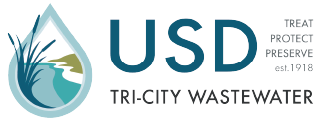Food Handling Pollution
What types of pollution do food handling facilities generate?
All substances left in a street, gutter, parking lot, or alley—or dumped into a storm drain—end up in local creeks and San Francisco Bay, with no treatment.
In addition to drawing flies, rodents, and causing odor and public health problems, decaying organic materials use up dissolved oxygen in streams and the Bay, stressing or killing aquatic animals.
Oil and grease can also plug sanitary sewer lines, causing sewer backups and severe risks to human health.
Food handling facilities sometimes discharge toxic chemicals, including cleaning products, disinfectants, and pesticides. Even biodegradable soaps contain ingredients that are initially toxic to aquatic life.
Sewer or Storm Drain
If you are not certain whether a drain leads to the storm drain or sanitary sewer, call Union Sanitary District ((510) 477-7500) so that we can help you resolve the question. In general, drains inside the building are connected to the sanitary sewer, and outside drains (except for capped sanitary sewer “cleanouts”) are connected to the storm drain system. Sanitary sewer cleanouts are usually 6 inches in diameter or smaller, and storm drain inlets are larger—but there are exceptions. You need to know for sure!

